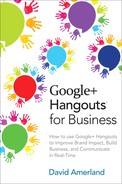Introduction
The world does not work that way anymore. The entry barrier to instant, visual, global communication has dropped to the price of a laptop and an Internet connection. Smartphones, tablets, and hotspots are turning the globe into a wired, connected community where the chatter never stops. The connectivity and real-time video contact that are now possible have transformed the identity-forming, trust-shaping game into something else—something new, more complicated, and, at the same time, more real and authentic.
Dealing with all this alone is a challenge that requires a different way of behaving online and a new way of marketing. But there is more. The connectivity, the “chatter,” has its own impetus and acts as its own catalyst. And from it, fresh value is now being unlocked, new ideas are arising, and new business opportunities are being born, as well as challenges the likes of which we have not seen before.
Foresight is the United Kingdom government wing that is charged with carrying out surveys that help to determine future government policies. In its latest commissioned survey of digital identity, webcams were described this way: “The latest version of increasingly ubiquitous online activity, this is a form of hyper realist identity with unprecedentedly intense face-to-face communication potentially changing our offline identity through increasing self-consciousness.”
Admittedly, self-consciousness is something that none of us envisaged as a problem on the Web. It has always been the place where we felt most at home, precisely because we could not be seen. We could play online games dressed in our underwear, do our banking wearing our pj’s, and never worry about being groomed, speaking clearly, or being able to articulate our thoughts on the go.
Nevertheless, here we are. The ability to visually connect with another person or group of people, any time, any place, from potentially anywhere, is radically changing the face of the Web. In the process it is also changing the ease with which we connect across the world, and inevitably it impacts upon the way we do business.
How?
In the days before the Internet, if you worked for a company, the place to hang out was the office water cooler. That’s where you met new people, caught up on the gossip, and exchanged all those bits of information that enabled you to do your job properly.
In the digital age of the connected economy, the office water cooler has gone. Workers are on the move; companies are frequently spread across countries, continents, and time zones. The commute to work has changed from time spent in the car or public transportation in order to put in a nine-to-five, into the time it takes to get from the bedroom to the home office and log on to the Web. The eight-hour day has shifted, fragmented, and, inevitably, expanded.
What has remained the same, however, is the need for the water cooler. The place to hang out, the capacity to catch up on gossip, shoot the breeze, find out something interesting and meet new people. Whether real or virtual the “water cooler” is a requirement for human contact in an environment that allows trust to form. Outside the office businesses used exhibitions, events, and public presentations as touchpoints with their audience. Those were the moments where one could talk to people and get a sense of the character of a business.
In the digital age that role has been taken over by the Hangout. The speed, stability, and ever-evolving functionality of the Google+ Hangout feature has, quietly, become the “increasingly ubiquitous online activity...with unprecedentedly intense face to face communication potential” that the U.K. government report mentioned.
As we are pushing deeper into the second decade of the twenty-first century and the real-time Web becomes the place where we go to chill as well as do business, the need for visual communication changes from a luxury that’s nice to have to a necessity we cannot do without. With it, we also change the way we communicate and the issues we communicate about. Hangouts and Hangouts on Air, on the commercial side of things, represent a totally new way of creating brand awareness, brand equity, and the all-important brand loyalty without which no business can survive.
In preparing this book I looked at the Hangout functionality in depth, examined the dynamics that govern it, and went through its technicalities. The result is this book. I hope that it’s useful and informative. Above all, I hope that it becomes the springboard you need to take your business to the next level and become part of the wave that will usher in fresh change in how business is done.
David Amerland
London
